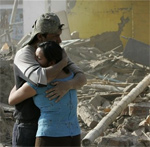Peru's Road to Reconstruction
February 14, 2008 - Americas Society- Council of the Americas
Danielle Renwick
 (left) Peruvians have worked toward rebuilding since an earthquake struck six months ago. (AP Images)
(left) Peruvians have worked toward rebuilding since an earthquake struck six months ago. (AP Images)
Six months ago, a major earthquake struck southern Peru, displacing tens of thousands of people. Yet, even as the central government responded swiftly to create reconstruction programs, some officials and local residents have complained since then of lagging rebuilding efforts.
In August 2007 the magnitude-7.9 earthquake shook the area around Ica (map). At the time, President Alan Garcia and cabinet members temporarily relocated to an air force base nearby to be on hand in the days following the disaster. Within weeks, Garcia’s administration established the South Reconstruction Fund (FORSUR). Start-up funds for the agency included $100 million from the central government as well as $38 million from international sources. Lima also implemented Bono 6000, a bond program allocating roughly $2,000 for home reconstruction per displaced family. As the Economist reported a month later, the fast response gave Garcia’s approval ratings a strong boost.
Despite the government’s initial action to jumpstart reconstruction efforts, FORSUR has since come under fire for being slow and bureaucratic. Within a month of the quake, Ica’s Governor Rómulo Treviño criticized FORSUR and started the Ica Corporation for Reconstruction and Development. In November, dissatisfied Ica residents organized a 24-hour strike on the Pan-American Highway, closing businesses and blocking access to the region. The group, who called themselves the “Victims of Ica” demanded faster access to aid and greater autonomy in rebuilding efforts, and called for the resignation of Julio Favre, a former head of Peru’s largest business association appointed to head up FORSUR.
The central government achieved a mark of success in January when Peru's Commission for the Formalization of Informal Property (COFOPRI) announced it would provide some 10,200 property deeds to families displaced by the disaster. Still, COFOPRI’s director also complained of foot-dragging on the part of FORSUR, which in September 2007 pledged--but never remitted--funds to COFOPRI in September 2007.
Favre in turn deflected blame. In January, he went before Peru’s Congress to defend himself and ask for more financial support, saying he has been hindered by a lack of resources and pointing out that Congress approved the national budget without allocating funds for FORSUR. At the time of the earthquake, Peru's minister of economy, Luis Carranza, estimated that new housing, energy, transportation, education, and health care infrastructure would cost $220 million, but Lima's Chamber of Commerce put that figure closer to $400 million.
The quake, which killed more than 500 people, was the first natural disaster of its magnitude to hit earthquake-prone Peru since 2001, when another 7.9 quake hit the area surrounding Arequipa.
In 1970, the Ancash region just north of Lima was hit by a 7.7-magnitude earthquake that killed over 70,000 people--the worst natural disaster in Peru’s history.
Current rebuilding efforts have coincided with Peru’s turn to host the Asia Pacific Economic Cooperation forum. Peru expects fifteen thousand people to visit for the 127 meetings to be held throughout the country and $18 million in tourist revenues from the summit. AS/COA hosted a recent panel discussing Peru's role as this year's host for APEC and holds its annual Latin American Cities Conference in Lima on September 4.